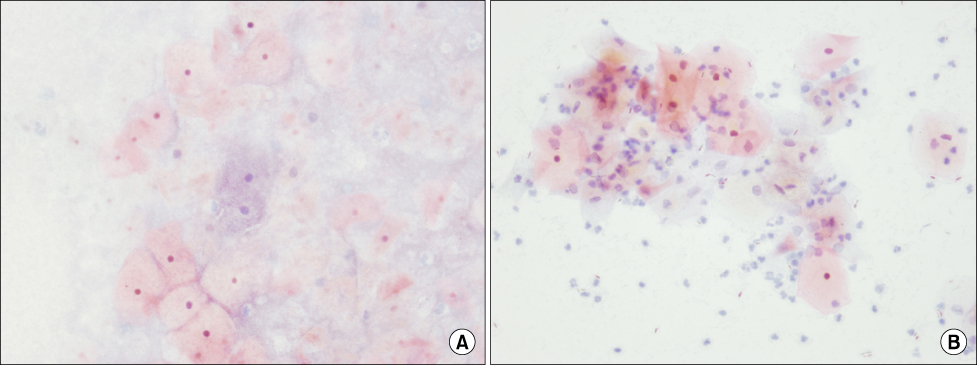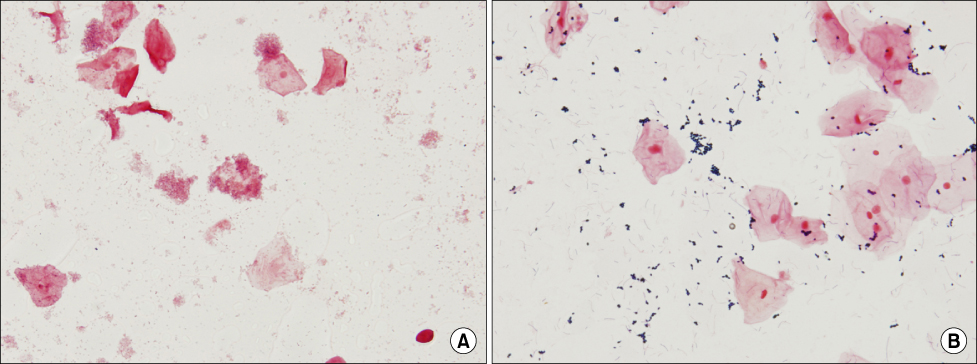Korean J Clin Microbiol.
2012 Sep;15(3):104-109. 10.5145/KJCM.2012.15.3.104.
Detection of Trichomonas vaginalis, Gardnerella vaginalis, and Candida Species in Affirm VPIII, Papanicolaou Smear Test and Gram Stain
- Affiliations
-
- 1Department of Obstetrics and Gynecology, Kangbuk Samsung Hospital, Sungkyunkwan University School of Medicine, Seoul, Korea.
- 2Department of Urology, Chung-Ang University College of Medicine, Seoul, Korea.
- 3Department of Laboratory Medicine, Chung-Ang University College of Medicine, Seoul, Korea. cpworld@cau.ac.kr
- 4Department of Pathology, Chung-Ang University College of Medicine, Seoul, Korea.
- KMID: 1434168
- DOI: http://doi.org/10.5145/KJCM.2012.15.3.104
Abstract
- BACKGROUND
Infectious vaginitis is caused primarily by three different groups of microbial pathogens (Trichomonas vaginalis, Candida spp., and Gardnerella vaginalis). The objective of this study was to compare the Affirm VPIII assay using a DNA hybridization technique with the Papanicolaou (Pap) smear test and the Gram stain in the detection and identification of these three organisms.
METHODS
A total of 300 vaginal samples were collected from women that were either symptomatic for vaginitis or asymptomatic women that were being seen for routine obstetric or gynecological care. The presence of T. vaginalis, Candida spp., and G. vaginalis was evaluated by using the Affirm VIII assay (Becton Dickinson, USA), Pap smear test, and Gram stain method, respectively.
RESULTS
With the Affirm VPIII assay, 1 (0.3%) patient tested positive for T. vaginalis, 99 (33.0%) patients were positive for G. vaginalis, and 18 (6.0%) were positive for Candida spp. The detection rates of Trichomonas infection, bacterial vaginosis and candidiasis by the Pap smear test and Gram stain method were 0.7% versus 0%, 16.3% versus 35.7%, and 1.7% versus 9.7%, respectively. The differences between the detection rates of the above three organisms between the Pap smear test and the Gram stain method were statistically significant (p<0.05).
CONCLUSION
The Affirm VPIII assay was more sensitive than the Pap smear test and more specific than the Gram stain method for the detection and identification of these three organisms. In addition, the results of the Affirm VPIII assay are quick to obtain and are simple and easy to interpret.
Keyword
MeSH Terms
Figure
Cited by 1 articles
-
Interpretation of Papanicolaou Smear Test and Gram Stain Results for the Diagnosis of Infectious Vaginitis is Affected by Knowledge of Additional Related Test Results
Bo Hyun Kim, Jun Hyung Lee, Oh Joo Kweon, Nae Yu, Mi-Kyung Lee
Lab Med Online. 2014;4(2):105-111. doi: 10.3343/lmo.2014.4.2.105.
Reference
-
1. Van Der Pol B. Diagnosing Vaginal Infections: It's Time to Join the 21st Century. Curr Infect Dis Rep. 2010. 12:225–230.2. Kent HL. Epidemiology of vaginitis. Am J Obstet Gynecol. 1991. 165:1168–1176.3. Angotti LB, Lambert LC, Soper DE. Vaginitis: making sense of over-the-counter treatment options. Infect Dis Obstet Gynecol. 2007. 2007:97424.4. Gravett MG, Hummel D, Eschenbach DA, Holmes KK. Preterm labor associated with subclinical amniotic fluid infection and with bacterial vaginosis. Obstet Gynecol. 1986. 67:229–237.5. Soper DE, Bump RC, Hurt WG. Bacterial vaginosis and trichomoniasis vaginitis are risk factors for cuff cellulitis after abdominal hysterectomy. Am J Obstet Gynecol. 1990. 163:1016–1021.6. Granato PA. Vaginitis: clinical and laboratory aspects for diagnosis. Clin Microbiol Newsletter. 2010. 32:111–116.7. Brown HL, Fuller DD, Jasper LT, Davis TE, Wright JD. Clinical evaluation of affirm VPIII in the detection and identification of Trichomonas vaginalis, Gardnerella vaginalis, and Candida species in vaginitis/vaginosis. Infect Dis Obstet Gynecol. 2004. 12:17–21.8. Gazi H, Degerli K, Kurt O, Teker A, Uyar Y, Caglar H, et al. Use of DNA hybridization test for diagnosing bacterial vaginosis in women with symptoms suggestive of infection. APMIS. 2006. 114:784–787.9. Levi AW, Harigopal M, Hui P, Schofield K, Chhieng DC. Comparison of Affirm VPIII and Papanicolaou tests in the detection of infectious vaginitis. Am J Clin Pathol. 2011. 135:442–447.10. Carr PL, Felsenstein D, Friedman RH. Evaluation and management of vaginitis. J Gen Intern Med. 1998. 13:335–346.11. Schwiertz A, Taras D, Rusch K, Rusch V. Throwing the dice for the diagnosis of vaginal complaints? Ann Clin Microbiol Antimicrob. 2006. 5:4.12. Amsel R, Totten PA, Spiegel CA, Chen KC, Eschenbach D, Holmes KK. Nonspecific vaginitis. Diagnostic criteria and microbial and epidemiologic associations. Am J Med. 1983. 74:14–22.13. Kingston MA, Bansal D, Carlin EM. 'Shelf life' of Trichomonas vaginalis. Int J STD AIDS. 2003. 14:28–29.14. Tokyol C, Aktepe OC, Cevrioglu AS, Altindis M, Dilek FH. Bacterial vaginosis: comparison of Pap smear and microbiological test results. Mod Pathol. 2004. 17:857–860.15. Sobel JD, Schmitt C, Meriwether C. A new slide latex agglutination test for the diagnosis of acute Candida vaginitis. Am J Clin Pathol. 1990. 94:323–325.16. Briselden AM, Hillier SL. Evaluation of affirm VP Microbial Identification Test for Gardnerella vaginalis and Trichomonas vaginalis. J Clin Microbiol. 1994. 32:148–152.17. Witt A, Petricevic L, Kaufmann U, Gregor H, Kiss H. DNA hybridization test: rapid diagnostic tool for excluding bacterial vaginosis in pregnant women with symptoms suggestive of infection. J Clin Microbiol. 2002. 40:3057–3059.
- Full Text Links
- Actions
-
Cited
- CITED
-
- Close
- Share
- Similar articles
-
- Interpretation of Papanicolaou Smear Test and Gram Stain Results for the Diagnosis of Infectious Vaginitis is Affected by Knowledge of Additional Related Test Results
- A Case of Neonatal Sepsis with Meningitis due to Gardnerella vaginalis
- Investigation of Hemophilus vaginalis in patients with Non-gonococcal Urethritis
- Correlation of Diagnostic 4 Signs, Bacterial Vaginosis and Gardnerella vaginalis Isolation and Drug - resistant Profiles of Clinical Isolates
- Immobilization-agglomeration reaction for the diagnosis of Trichomonas vaginalis infection




